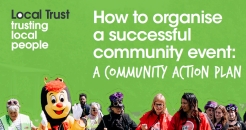 Organising successful community events: an action plan
Organising successful community events: an action plan
From a guide by Local Trust
Organizing successful community events fosters connection, celebrates diversity, and provides affordable activities for families while strengthening local collaboration and leadership. A comprehensive guide by Local Trust offers a step-by-step action plan to help communities design, plan, promote, and execute events that are inclusive, safe, and impactful.
Community events build a sense of belonging by bringing people together and enhancing positivity about local areas. They celebrate cultural diversity through shared experiences, offer low-cost family entertainment, and create opportunities for community consultation and involvement. Events also foster new collaborations and showcase local talent and businesses, enriching community life.
Designing your event should involve:
-
Community Input: Engage residents, especially underrepresented voices, through surveys, meetings, and social media to ensure the event reflects community desires.
-
Vision Development: Define clear goals, target audiences, desired atmosphere, event name, and expected attendance.
-
Partnerships: Collaborate with resident groups, local businesses, and organizations to share resources and expertise, establishing communication and meeting routines.
Careful financial planning of the event involves listing all costs (e.g. venue, food, entertainment, promotion), income sources (e.g. grants, sponsorships, donations), and setting a contingency fund. Budgeting should focus on value, spreading expenditure across multiple effective items rather than one costly element. Funding can be sought from local councils, businesses, and national community funds.
Getting into detail:
-
Date and Venue: Choose dates suitable for target audiences, avoiding clashes with other events and considering seasonal or religious factors. Select accessible venues with appropriate facilities and contingency for weather.
-
Timeline: Begin planning 3-8 months ahead depending on event size, booking venues and suppliers early, maintaining contact lists, and scheduling regular partner check-ins.
-
Activities: Offer diverse, inclusive, and low-cost activities appealing to different preferences and energy levels, reflecting community diversity and enabling talent showcases.
-
Catering: Plan food carefully, catering to varied dietary needs and ensuring hygiene standards. Food should be a welcoming feature, with options like Halal, vegetarian, and vegan, and served in environmentally friendly ways.
-
Environmental Considerations: Minimize waste by using reusable or compostable items, recycling stations, and encouraging sustainable transport. Plan post-event clean-up.
-
Safety and Safeguarding: Obtain necessary permissions and complete risk assessments. Develop first aid plans and verify insurance for all parties. Plan for adequate security and safeguarding to protect children and vulnerable adults, including staff briefings, supervision ratios, lost child points, and consent processes for photography. Prepare contingency plans for weather or unexpected issues and test equipment in advance.
-
Volunteer Management: Volunteers are crucial; define clear roles, recruit sufficient numbers, and consider paid roles for demanding tasks. Provide briefings on roles, safety, safeguarding, and communication protocols to ensure smooth operations.
-
Inclusivity and Welcome: Use warm, inclusive language in all communications. Reflect community diversity in activities and food. Provide clear information about accessibility and event expectations. Translate materials into common local languages to reach all community members.
-
Photography and Filming: Manage media carefully by briefing photographers and volunteers, implementing consent forms, opt-out systems (e.g., stickers or wristbands), and clear notices about usage and privacy to respect attendees’ rights.
-
Promoting Your Event: Start promotion 6-8 weeks in advance with a simple plan targeting channels used by your community, such as newsletters, social media, and local groups. Use clear, inclusive language that fosters belonging and translates key information into local languages. Create eye-catching visuals using tools like Canva and ensure essential details are prominent. Utilize social media actively, posting varied content with calls to action and reminders to maximize reach. Engage local media with press releases and stories to broaden awareness.
On the day:
-
Arrive early to set up welcome points, signage, and notices.
-
Brief volunteers thoroughly on roles, emergency procedures, safeguarding, and photography opt-out.
-
Stay flexible and ready to troubleshoot challenges using contingency plans.
-
Collect feedback through surveys, boards, or digital tools to learn and improve.
-
Enjoy the event and appreciate the community engagement it fosters.
After the event:
-
Send thank-you messages to volunteers, partners, and suppliers.
-
Share positive feedback and event highlights via social media and local media.
-
Conduct debrief sessions to evaluate achievements, challenges, and lessons learned.
-
Consider future collaborations and the potential for the event to become a regular community fixture.
The guide also points to resources on accessibility, health and safety, safeguarding, and local authority event planning templates to support organizers in meeting legal and practical requirements.
Download the guide here.
Retweet about this article:
From a guide by Local Trust, 25/11/2025